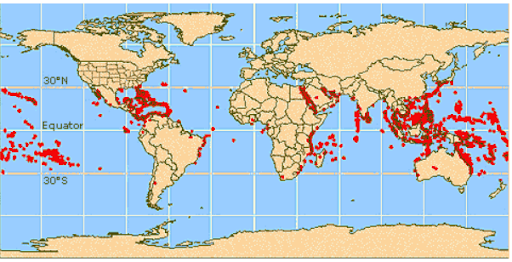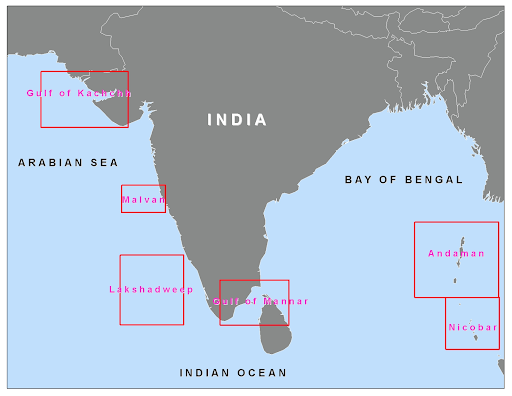TN Forest Dept to take up Mitigation measures in Gulf of Mannar Marine National Park
What’s the news?
- The Tamil Nadu Forest Department will take up mitigation measures and put up a strict monitoring regime to negate any impact on corals, and the marine ecosystem, in the Gulf of Mannar Marine National Park, by the proposed thermal power plants.
- Initially, the Forest Department will conduct a detailed baseline data collection on the marine flora and fauna including ecologically-sensitive habitats (corals and sea grasses) and fish population, and will compare this data with baseline data collected during the Environment Impact Assessment study prior to the start of the project.
- The Department will also be monitoring temperature and salinity (both surface and bottom water) once in 15 days (fortnightly), for a total of 24 times in a year.
Coral reefs
- Coral reefs are large underwater structures composed of the skeletons of colonial marine invertebrates called coral.
- The coral species that build reefs are known as hermatypic, or “hard,” corals because they extract calcium carbonate (CaCO3) from seawater to create a hard, durable exoskeleton that protects their soft, sac-like bodies.
- Other species of corals that are not involved in reef building are known as “soft” corals. These types of corals are flexible organisms often resembling plants and trees and include species such as sea fans and sea whips.
Symbiotic relationship
- Most reef-building corals contain photosynthetic algae, called zooxanthellae, that live in their tissues. The corals and algae have a symbiotic relationship.
- The coral provides the algae with a protected environment and compounds they need for photosynthesis. In return, the algae produce oxygen and help the coral to remove wastes. The presence of the zooxanthellae also provides colored pigments to help protect the coral’s white skeleton from sunlight.
Significance of Coral reefs
- Coral reefs only occupy 0.1% of the area of the ocean but they support 25% of all marine species on the planet.
- Because of the diversity of life found in the habitats created by corals, reefs are often called the “rainforests of the sea.”
Geographical distribution
-
- The reef-building corals prefer to grow at
- depths shallower than 30 m (100 ft), or
- where the temperature range is between 16-32°C, and
- The reef-building corals prefer to grow at
- light levels are high
- The majority of reef building corals are found within tropical and subtropical waters. These typically occur between 30°N and 30°S of the equator.
- The largest of these coral reef systems, the Great Barrier Reef in Australia, is more than 1,500 miles long (2,400 kilometers).

Coral reefs in India
- Coral reefs are present in the areas of Gulf of Kutch, Gulf of Mannar, Andaman & Nicobar, Lakshadweep Islands and Malvan coast of Maharashtra.

About Gulf of Mannar Marine National Park
- The Gulf of Mannar Marine National Park spreads along a 560 Km stretch between Rameswaram and Tuticorin in Tamil Nadu. It is also designated as a Biosphere Reserve by UNESCO and is the first Marine Biosphere Reserve in South and SouthEast Asia.
- The Gulf of Mannar endowed with three distinct Coastal ecosystems namely coral reef, seagrass bed and mangroves is considered one of the world’s richest regions from a marine biodiversity perspective, is known for its unique biological wealth and is a storehouse of marine diversity of global significance.
- The Gulf’s 4,223 species of plants and animals representing from primitive to higher forms make it one of the richest coastal regions in India.
- Most of the islands have luxuriant growth of mangroves on their shorelines and swampy regions. The sea bottom of the inshore area around the islands are carpeted with seagrass beds which serve as ideal feeding ground for Dugong dugon, the endangered herbivorous marine mammal.
- Seagrass beds serve as nursery and spawning grounds for diverse biota and habitat for macro and micro algae as epiphytes. This habitat is the feeding grounds for the largest endangered marine mammal Dugong i.e., Dugong dugon and, also, sea turtles.
- This area is also the last refuge of an invertebrate, the unique ‘living fossil’ Balanoglossus that links vertebrates and invertebrates. It is also important for crustaceans, molluscs, echinoderms, fishes, turtles and many other mammals.
References:
Subscribe
Login
0 Comments
